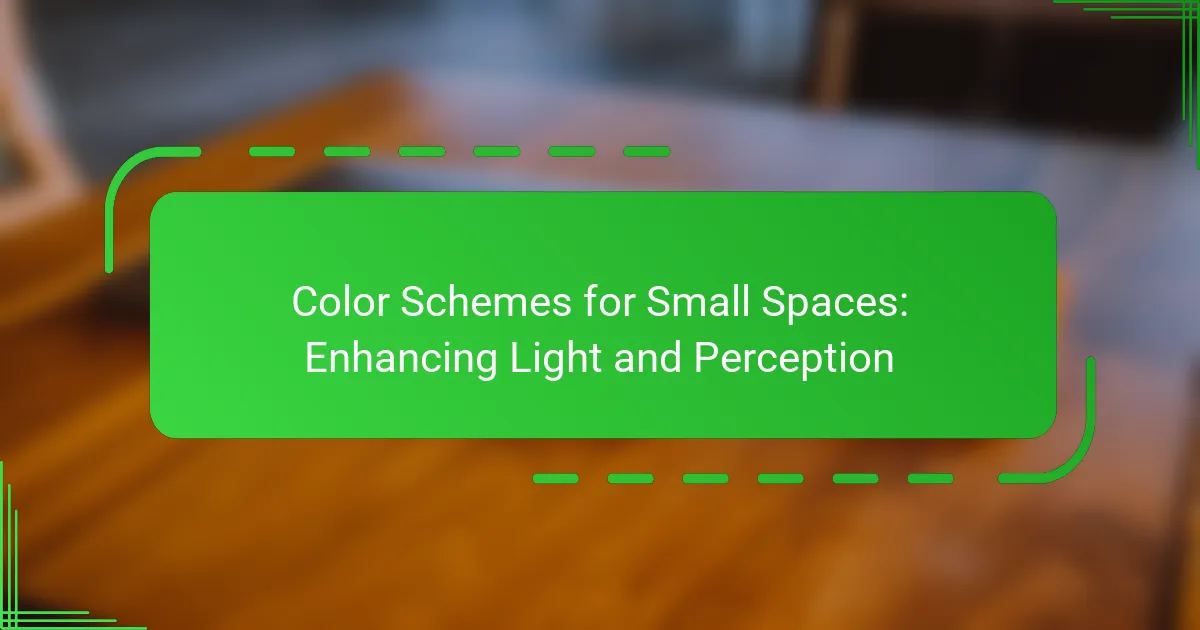Color schemes for small spaces utilize lighter hues to enhance the perception of space and create an airy atmosphere. Light colors, such as whites, beiges, and soft grays, reflect more light, making rooms appear larger and more open. This article outlines effective strategies for selecting color palettes that optimize small areas, including the use of neutral shades and strategic accent colors to add personality without overwhelming the space. Additionally, it discusses the benefits of monochromatic schemes and the role of mirrors in enhancing light and depth. Research indicates that lighter colors can increase the perceived size of a room by up to 20%, making them a practical choice for compact living environments.

What are Color Schemes for Small Spaces?
Color schemes for small spaces utilize lighter hues to create an illusion of space. Light colors reflect more light, making a room feel larger and more open. Neutral shades like whites, beiges, and soft grays are popular choices. These colors enhance natural light and provide a calming effect. Accent colors can be used sparingly to add personality without overwhelming the space. For example, a single wall painted in a bold color can create a focal point. Additionally, using a monochromatic color scheme can unify the space and simplify the design. Research shows that light colors can increase the perceived size of a room by up to 20%.
How do color schemes influence the perception of small spaces?
Color schemes significantly influence the perception of small spaces by affecting how light and size are perceived. Lighter colors, such as whites and pastels, create an illusion of openness. These shades reflect more light, making the space feel larger and airier. Darker colors, on the other hand, can make a room feel more enclosed. They absorb light, which can lead to a sense of confinement.
Studies show that color can impact mood and spatial awareness. For example, a study published in the Journal of Environmental Psychology indicates that lighter colors can enhance feelings of spaciousness. Additionally, the use of monochromatic color schemes can unify a space, further enhancing the perception of size.
In summary, the choice of color scheme plays a crucial role in how small spaces are experienced, influencing both visual perception and emotional response.
What psychological effects do colors have on space perception?
Colors significantly influence space perception by altering how we perceive size, depth, and atmosphere. Lighter colors, such as whites and pastels, create an illusion of spaciousness. They reflect more light, making a room feel larger and more open. Darker colors, like deep blues or browns, can make a space feel smaller and more intimate. This effect occurs because darker hues absorb light, reducing brightness in the environment.
The psychological impact of colors also extends to emotional responses. For example, blue tones often evoke calmness and serenity, while warmer colors like red can stimulate energy and excitement. Research published in the journal “Color Research and Application” highlights how colors affect mood, which in turn can influence spatial perception. The study indicates that color choices can enhance or diminish the perceived size of a space based on emotional associations.
In summary, colors affect space perception by influencing perceived dimensions and emotional responses, which can be strategically used in design.
How can color schemes create an illusion of space?
Color schemes can create an illusion of space by using light and dark contrasts effectively. Lighter colors tend to reflect more light, making a room appear larger and more open. Darker colors absorb light, which can make spaces feel smaller and more enclosed.
Using a monochromatic color scheme can also enhance the perception of space. This approach creates a seamless flow, reducing visual clutter. Additionally, cool colors like blues and greens can create a sense of calm and depth, further expanding the visual space.
Contrastingly, warm colors can create a cozy atmosphere but may visually shrink a room. Accent walls in darker shades can define areas without overwhelming the space. Overall, strategic color choices can significantly influence how spacious a room feels.
Why is it important to choose the right color scheme for small spaces?
Choosing the right color scheme for small spaces is crucial for enhancing the perception of space. Light colors can make a room feel larger and more open. Dark colors tend to create a cozy but constrictive effect. Research by the National Association of Realtors indicates that lighter shades can increase the appeal of small rooms. Additionally, colors can influence mood and ambiance, affecting how one feels in a space. For example, blues and greens are calming, while yellows can energize. The right color scheme can also optimize natural light, making a small area appear brighter. Thus, selecting an appropriate color palette is essential for maximizing both aesthetics and functionality in small spaces.
What role does lighting play in color selection for small areas?
Lighting significantly influences color selection for small areas. It affects how colors are perceived, altering their appearance. Natural light can enhance warm tones, making them feel inviting. In contrast, artificial light may shift colors, sometimes making them appear cooler or duller. The type of bulb used, such as LED or incandescent, also impacts color perception. For instance, LED lights can create a stark contrast, while incandescent bulbs provide a softer glow. Therefore, choosing colors for small spaces requires considering the lighting conditions. This ensures that the selected colors achieve the desired aesthetic and spatial effect.
How can color schemes enhance the functionality of small spaces?
Color schemes can enhance the functionality of small spaces by creating an illusion of depth and openness. Light colors, such as whites and pastels, reflect more light, making a room feel larger. Dark colors can create cozy nooks but may make a space feel smaller. Strategic color placement can define areas within a small room, aiding in organization. For instance, using a darker shade on one wall can create a focal point without overwhelming the space. Additionally, cohesive color palettes can unify different areas, promoting a sense of flow. Research shows that color can significantly influence perception and mood, affecting how spacious a room feels.

What types of color schemes are effective for small spaces?
Light color schemes are effective for small spaces. These schemes typically include whites, pastels, and light neutrals. Light colors reflect more light, making the space feel larger. Dark colors absorb light, which can make a room appear smaller. Monochromatic color schemes also work well in small spaces. They create a cohesive look that enhances the perception of space. Additionally, using an accent color can add interest without overwhelming the area. According to design experts, such as those from the American Society of Interior Designers, lighter colors can significantly enhance the overall ambiance of compact areas.
What are the most popular color schemes for small rooms?
The most popular color schemes for small rooms include light neutrals, pastel shades, and monochromatic palettes. Light neutrals, such as whites and beiges, create an airy feel. Pastel shades, like soft blues and greens, add a calming effect. Monochromatic palettes use varying shades of a single color to create depth. These schemes enhance light and make spaces appear larger. According to a study by the American Society of Interior Designers, lighter colors reflect more light, improving the perception of space.
How do monochromatic color schemes work in small spaces?
Monochromatic color schemes work in small spaces by creating a cohesive and harmonious environment. This approach uses variations of a single color, including different shades, tints, and tones. Such a scheme can visually expand a space, making it feel larger and more open. Lighter shades reflect more light, enhancing brightness in confined areas. Darker shades can add depth without overwhelming the space. This technique minimizes visual clutter and promotes a sense of tranquility. Studies show that cohesive color schemes can improve mood and perception of space. Overall, monochromatic schemes are effective for optimizing small areas while maintaining aesthetic appeal.
What are the benefits of complementary color schemes in compact areas?
Complementary color schemes in compact areas enhance visual interest and depth. They create contrast, making spaces feel more dynamic. This contrast can trick the eye into perceiving a larger area. Additionally, complementary colors can highlight specific features or furniture. They also promote balance, preventing overwhelming color saturation. According to color theory, such schemes can evoke emotional responses. The use of complementary colors can improve lighting perception in small spaces. This method is effective in maximizing the aesthetic appeal of compact areas.
How do warm and cool colors affect small spaces differently?
Warm colors make small spaces feel cozier and more intimate. They can create an inviting atmosphere. Examples include reds, oranges, and yellows. These colors tend to advance visually. This can make a room feel smaller. Cool colors, such as blues, greens, and purples, have the opposite effect. They create a sense of calm and spaciousness. Cool colors recede visually, making spaces appear larger. Studies show that light colors reflect more light. This enhances the perception of space. Conversely, dark warm colors can absorb light, making a space feel more confined.
What are the advantages of using warm colors in small rooms?
Warm colors in small rooms create a cozy and inviting atmosphere. These colors, such as reds, oranges, and yellows, can make a space feel more intimate. Warm colors stimulate the senses and can enhance feelings of comfort. They can also help to visually warm up a room that lacks natural light. Studies show that warm colors can influence mood positively, making spaces feel more cheerful. Additionally, they can create the illusion of a more spacious environment by drawing the eye inward. Using warm colors strategically can highlight architectural features, adding depth to the room. Overall, warm colors effectively enhance the perception of small spaces.
How can cool colors contribute to a calming atmosphere in tight spaces?
Cool colors can create a calming atmosphere in tight spaces. These colors include shades of blue, green, and violet. They are known to evoke feelings of tranquility and relaxation. Research indicates that cool colors can lower heart rates and reduce stress levels. This effect is particularly beneficial in confined areas, where a sense of openness is desired. Light blue, for example, can mimic the sky, making a space feel more expansive. Additionally, cool colors reflect light well, enhancing brightness without overwhelming the senses. Overall, using cool colors in small spaces fosters a serene environment conducive to relaxation.

What practical tips can enhance color schemes in small spaces?
Use light colors to make small spaces feel larger. Light hues reflect more light, creating an airy atmosphere. Consider white, soft pastels, or light neutrals for walls. These colors help open up the room visually. Incorporate accent colors through decor and furnishings. This adds interest without overwhelming the space. Use mirrors strategically to reflect light and colors. Mirrors can create the illusion of depth and brightness. Limit dark colors to small areas or accents. Dark shades can make a space feel cramped if overused. Choose a cohesive color palette to unify the space. A well-planned scheme enhances flow and visual appeal.
How can you effectively combine colors in a small room?
To effectively combine colors in a small room, use a cohesive color palette. Choose a dominant color for the walls to create a base. Select two or three complementary colors for accents in decor and furnishings. Light colors can make a small room feel larger and more open. Dark colors can add depth but should be used sparingly. Consider using a monochromatic scheme for a sophisticated look. Utilize patterns and textures to add interest without overwhelming the space. According to color theory, harmonious combinations can enhance the perception of space.
What are the best practices for selecting accent colors?
To select accent colors effectively, consider the overall color scheme. Choose colors that complement the dominant hues in the space. Use color theory principles, such as complementary or analogous colors, to create harmony. Limit the number of accent colors to maintain cohesion. Test colors in different lighting conditions to see how they appear. Use samples to visualize how colors interact with existing decor. Keep in mind the emotional impact of colors; warm tones can energize, while cool tones can calm. These practices enhance the aesthetic appeal of small spaces.
How can you use color to highlight architectural features?
Color can be used to highlight architectural features by strategically applying contrasting shades. This technique draws attention to specific elements such as moldings, columns, or arches. For instance, painting a doorway a bold color can make it a focal point. Lighter colors can enhance the perception of space, while darker shades can create depth. Accent colors can also be used to emphasize unique details, like decorative trims. According to color theory, contrast increases visibility and interest. Research shows that color choices can influence how we perceive the size and shape of a room. Thus, careful color selection enhances architectural features effectively.
What common mistakes should be avoided when choosing color schemes for small spaces?
Common mistakes to avoid when choosing color schemes for small spaces include using dark colors excessively. Dark colors can make a space feel cramped and uninviting. Another mistake is neglecting to consider natural light. Rooms with limited sunlight may benefit from lighter shades to enhance brightness. Additionally, failing to create a cohesive color palette can lead to a disjointed appearance. A harmonious scheme helps unify the space visually. Overloading with too many colors is also a mistake. A limited palette can create a more spacious feel. Lastly, ignoring the scale of furniture and decor in relation to color can disrupt balance. Properly scaled items in suitable colors maintain a sense of proportion.
How can overusing dark colors negatively impact small areas?
Overusing dark colors in small areas can create a sense of confinement and reduce perceived space. Dark colors absorb light, making a room feel smaller and less inviting. This can lead to a gloomy atmosphere, negatively affecting mood and comfort. Research indicates that lighter colors can enhance the perception of space by reflecting more light. According to the Journal of Environmental Psychology, color choices significantly influence spatial perception and emotional responses. Therefore, excessive use of dark colors can detract from the overall ambiance and functionality of small spaces.
What are the pitfalls of neglecting natural light in color selection?
Neglecting natural light in color selection can lead to poor aesthetic outcomes. Colors may appear differently in artificial light compared to natural light. This discrepancy can result in a space feeling darker or more cramped than intended. For instance, warm colors may lose their vibrancy without adequate natural light. Additionally, cool colors can seem cold and uninviting in low-light conditions. Selecting colors without considering natural light can also affect mood and perception. Studies show that natural light enhances color accuracy and overall ambiance. Therefore, ignoring this factor can diminish the intended design impact.
Color schemes for small spaces focus on utilizing lighter hues to enhance the perception of space and light. The article explores how these color choices, including light neutrals and monochromatic palettes, can create an illusion of openness while influencing mood and emotional responses. It examines the psychological effects of colors, the importance of lighting, and practical tips for selecting and combining colors to optimize small areas. Additionally, the article highlights common mistakes to avoid, such as overusing dark colors and neglecting natural light, to ensure a harmonious and spacious environment.
